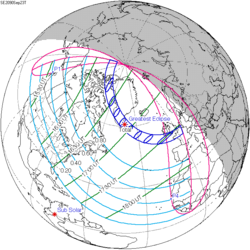Saros 157
This eclipse is a part of Saros series 157, repeating every 18 years, 11 days, and containing 70 events. The series will start with a partial solar eclipse on June 21, 2058. It contains annular eclipses from August 25, 2166 through March 10, 2491; hybrid eclipses from March 22, 2509 through April 12, 2545; and total eclipses from April 24, 2563 through April 21, 3158. The series ends at member 70 as a partial eclipse on July 17, 3302. Its eclipses are tabulated in three columns; every third eclipse in the same column is one exeligmos apart, so they all cast shadows over approximately the same parts of the Earth.
The longest duration of annularity will be produced by member 15 at 4 minutes, 16 seconds on November 22, 2310, and the longest duration of totality will be produced by member 38 at 5 minutes, 57 seconds on July 31, 2725. All eclipses in this series occur at the Moon’s ascending node of orbit. [4]
Tritos series
This eclipse is a part of a tritos cycle, repeating at alternating nodes every 135 synodic months (≈ 3986.63 days, or 11 years minus 1 month). Their appearance and longitude are irregular due to a lack of synchronization with the anomalistic month (period of perigee), but groupings of 3 tritos cycles (≈ 33 years minus 3 months) come close (≈ 434.044 anomalistic months), so eclipses are similar in these groupings.
The partial solar eclipses on December 7, 2170 (part of Saros 164) and November 7, 2181 (part of Saros 165) are also a part of this series but are not included in the table below.
| Series members between 1801 and 2105 |
|---|

September 28, 1810
(Saros 131) | 
August 27, 1821
(Saros 132) | 
July 27, 1832
(Saros 133) | 
June 27, 1843
(Saros 134) | 
May 26, 1854
(Saros 135) |

April 25, 1865
(Saros 136) | 
March 25, 1876
(Saros 137) | 
February 22, 1887
(Saros 138) | 
January 22, 1898
(Saros 139) | 
December 23, 1908
(Saros 140) |

November 22, 1919
(Saros 141) | 
October 21, 1930
(Saros 142) | 
September 21, 1941
(Saros 143) | 
August 20, 1952
(Saros 144) | 
July 20, 1963
(Saros 145) |

June 20, 1974
(Saros 146) | 
May 19, 1985
(Saros 147) | 
April 17, 1996
(Saros 148) | 
March 19, 2007
(Saros 149) | 
February 15, 2018
(Saros 150) |

January 14, 2029
(Saros 151) | 
December 15, 2039
(Saros 152) | 
November 14, 2050
(Saros 153) | 
October 13, 2061
(Saros 154) | 
September 12, 2072
(Saros 155) |

August 13, 2083
(Saros 156) | 
July 12, 2094
(Saros 157) | 
June 12, 2105
(Saros 158) |
Inex series
This eclipse is a part of the long period inex cycle, repeating at alternating nodes, every 358 synodic months (≈ 10,571.95 days, or 29 years minus 20 days). Their appearance and longitude are irregular due to a lack of synchronization with the anomalistic month (period of perigee). However, groupings of 3 inex cycles (≈ 87 years minus 2 months) comes close (≈ 1,151.02 anomalistic months), so eclipses are similar in these groupings.
| Series members between 1801 and 2200 |
|---|

January 30, 1805
(Saros 147) | 
January 9, 1834
(Saros 148) | 
December 21, 1862
(Saros 149) |

December 1, 1891
(Saros 150) | 
November 10, 1920
(Saros 151) | 
October 21, 1949
(Saros 152) |

October 2, 1978
(Saros 153) | 
September 11, 2007
(Saros 154) | 
August 21, 2036
(Saros 155) |

August 2, 2065
(Saros 156) | 
July 12, 2094
(Saros 157) | 
June 23, 2123
(Saros 158) |

June 3, 2152
(Saros 159) | 
May 13, 2181
(Saros 160) | |
















































































